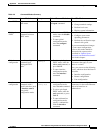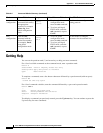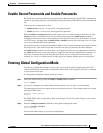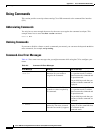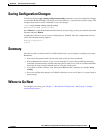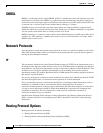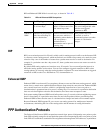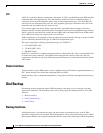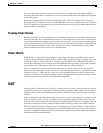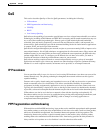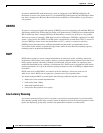
B-3
Cisco 1800 Series Integrated Services Routers (Fixed) Software Configuration Guide
OL-6426-02
Appendix B Concepts
PPP Authentication Protocols
RIP and Enhanced IGRP differ in several ways, as shown in Table B-1.
RIP
RIP is an associated protocol for IP, and is widely used for routing protocol traffic over the Internet. RIP
is a distance-vector routing protocol, which means that it uses distance (hop count) as its metric for route
selection. Hop count is the number of routers that a packet must traverse to reach its destination. For
example, if a particular route has a hop count of 2, then a packet must traverse two routers to reach its
destination.
By default, RIP routing updates are broadcast every 30 seconds. You can reconfigure the interval at
which the routing updates are broadcast. You can also configure triggered extensions to RIP so that
routing updates are sent only when the routing database is updated. For more information on triggered
extensions to RIP, see the Cisco IOS Release 12.3 documentation set.
Enhanced IGRP
Enhanced IGRP is an advanced Cisco proprietary distance-vector and link state routing protocol, which
means it uses a metric more sophisticated than distance (hop count) for route selection. Enhanced IGRP
uses a metric based on a successor, which is a neighboring router that has a least-cost path to a
destination that is guaranteed not to be part of a routing loop. If a successor for a particular destination
does not exist but neighbors advertise the destination, the router must recompute a route.
Each router running Enhanced IGRP sends hello packets every 5 seconds to inform neighboring routers
that it is functioning. If a particular router does not send a hello packet within a prescribed period,
Enhanced IGRP assumes that the state of a destination has changed and sends an incremental update.
Because Enhanced IGRP supports IP, you can use one routing protocol for multiprotocol network
environments, minimizing the size of the routing tables and the amount of routing information.
PPP Authentication Protocols
The Point-to-Point Protocol (PPP) encapsulates network layer protocol information over point-to-point
links. PPP originally emerged as an encapsulation protocol for transporting IP traffic over point-to-point
links. PPP also established a standard for the assignment and management of IP addresses, asynchronous
Table B-1 RIP and Enhanced IGRP Comparison
Protocol Ideal Topology Metric Routing Updates
RIP Suited for topologies with
15 or fewer hops.
Hop count. Maximum hop
count is 15. Best route is one
with lowest hop count.
By default, every 30 seconds.
You can reconfigure this value
and also use triggered
extensions to RIP.
Enhanced
IGRP
Suited for large topologies
with 16 or more hops to
reach a destination.
Distance information. Based
on a successor, which is a
neighboring router that has a
least-cost path to a
destination that is
guaranteed to not be part of
a routing loop.
Hello packets sent every
5 seconds, as well as
incremental updates sent when
the state of a destination
changes.



